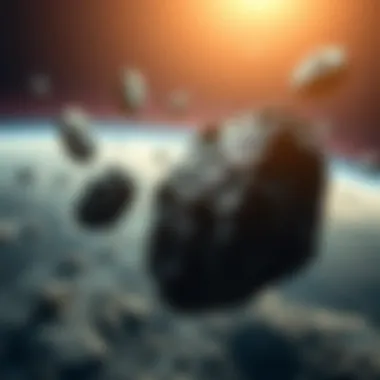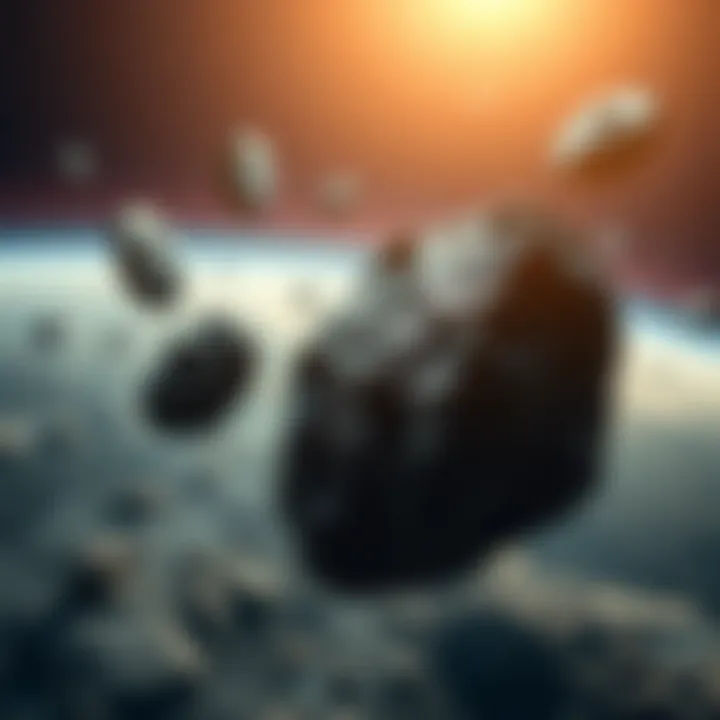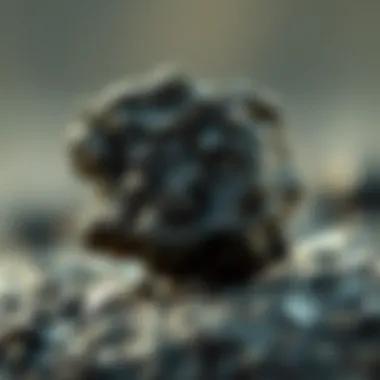Discovering the Intriguing Universe of Space Meteorites


History and Origins
Meteorites have captivated human curiosity for millennia, acting as tangible links to the cosmos. These fragments that fall from the heavens have their own unique histories, shaped by the celestial environments from which they come. Most meteorites are remnants from asteroids or comets; they carry with them stories of formation and cosmic cataclysms, going back billions of years. Understanding where they originate can provide insights into not just our solar system's history but also the foundational materials that make up Earth itself.
Overview of Collectibles, Rocks, and Fossils
For collectors, meteorites represent a conversation starter like no other. Unlike fossils or gemstones, which tell a story of life and Earth’s geological processes, meteorites invite discussions about the universe's birth and evolution. Each piece has its own character, often recognized by unique features such as fusion crusts – a glossy outer layer formed during atmospheric entry – or chondrules – small spherical inclusions from their parent bodies.
When comparing these cosmic treasures with rocks and fossils, one may appreciate the sheer age that meteorites often boast. Many terrestrial rocks form over milder timescales, while the origin of meteorites often dates back to the very formation of the solar system, roughly 4.6 billion years ago. It's almost like having a piece of history sitting on your shelf, ready to share its tale.
Historical Significance and Cultural Impact
Throughout history, meteorites have held a place of reverence in various cultures. In ancient civilizations, they were often viewed as messages from the gods or divine omens. For instance, the ancient Egyptians considered a particular meteorite called "the Stone of Heaven" as a powerful artifact of the divine, while in other cultures, meteorites inspired folklore and religious narratives.
More recently, meteorites influenced science and technology. The discovery of the first scientifically recognized meteorite, the Sikhote-Alin, in Russia in 1947 confirmed the extraterrestrial nature of these celestial objects. This paved the way for further studies, leading to insights that would shape our understanding of planetary formation and even the origins of life.
Meteorites today not only excite scientific inquiry but also foster a thriving collecting community. The thrill of discovering or obtaining a rare specimen drives collectors to share knowledge and stories, often forming connections that transcend geographical boundaries.
Important Note: Collecting meteorites often brings up legal and ethical queries regarding ownership, especially for finds in protected areas or those of significant scientific importance. Understanding these nuances is crucial for both collectors and scientists.
As one delves deeper into the fascinating world of meteorites, it becomes clear that their value extends far beyond their physical presence. They embody cosmic stories and cultural legacies, making them integral not only to the field of geology but also to humanity's eternal quest for knowledge about our place in the universe.
Preamble to Space Meteorites
Space meteorites offer a unique glimpse into the universe’s past. They are not mere rocks; they are remnants of ancient celestial bodies, having traveled vast distances before their descent to Earth. This section sets the stage for comprehending the profound relevance of these objects, not only in scientific research but also in cultural contexts, as they conjure our curiosity about the cosmos.
The exploration of space meteorites is crucial for several reasons. First, it allows us to understand the formation and evolution of our solar system. By studying these rocks, researchers can piece together the history written in their chemistry and mineralogy. Second, meteorites act as time capsules, preserving information from billions of years ago, much like a time-traveling portal into the solar system’s formative years.
Moreover, the significance of meteorites extends beyond the scientific realm. Culturally, they have inspired myths and narratives across civilizations. From ancient tales about fallen stars to their prominent role in contemporary science fiction, meteorites capture the human imagination.
To kick off this exploration, we will delve into the definition and overview of space meteorites, clarifying what they are and their importance within the broader context of planetary science. It is essential to recognize that each meteorite carries a story that intertwines science with culture, shaping how we view the universe and our place in it.
"Meteorites are like narratives inscribed in stone, telling tales of cosmic events that we are only beginning to understand."
In the subsequent sections, we will dissect the origins, classifications, recovery processes, and their scientific and cultural significance, providing an extensive overview of all facets relevant to enthusiasts, collectors, and scholars. Each segment will illuminate different aspects, contributing to a comprehensive understanding of these celestial messengers.
The Origins of Meteorites
The exploration of meteorites not only serves as a captivating gateway into cosmic phenomena but also reveals crucial insights into the very fabric of our solar system. Understanding the origins of meteorites is essential, as it aids scientists and collectors alike in deciphering the history of celestial bodies, the formation of planetary systems, and the compositions that can shed light on the building blocks of life itself. In this discussion, we delve into the formation processes of meteorites and explore how asteroids and comets play pivotal roles in their journey towards Earth.
Formation within the Solar System
Meteorites are remnants of the early solar system, offering a glimpse into the conditions that prevailed over 4.5 billion years ago. These space rocks originate from various celestial sources, primarily asteroids, as well as comets and planetary bodies, that have endured countless collisions and transformations through time. When a celestial body undergoes a violent impact, pieces can break away and venture into space, subsequently on a collision course with Earth.
Primarily, meteorites are categorized into three main types: stony meteorites, iron meteorites, and stony-iron meteorites. Each type tells a unique story. For instance, stony meteorites, predominantly formed from silicate minerals, act as historical records of asteroids that have remained largely unchanged since their formation. Alternatively, iron meteorites, made up of nickel-iron alloys, suggest the core of larger protoplanets. The importance of studying these differences cannot be overstated; discerning the specific origins of these meteorites aids significantly in understanding the processes that shaped our solar system.
Meteorites occasionally bear peculiar features and chemical compositions that puzzle researchers. Analyzing their isotopic ratios can unravel the mystery of their origins and the conditions under which these space rocks formed.
Asteroids and Comet Contributions
Among the solar system's diverse array of celestial bodies, asteroids and comets stand out as primary contributors to meteoritic material. Asteroids, the rocky leftovers from planetary formation, are abundant in the asteroid belt between Mars and Jupiter. They range from the size of a pebble to hundreds of kilometers in diameter. When influenced by gravitational forces, these asteroids can collide with one another, and some fragments are likely propelled towards the Earth.
Comets, on the other hand, are icy bodies carrying gas, ice, and dust. These ancient artifacts originate from the far reaches of the solar system, such as the Kuiper Belt and the Oort Cloud. As comets journey close to the Sun, they release gas and dust, creating beautiful tails. These outbursts can sometimes lead to meteoroid showers as particles break off and linger in space.
The contributions of these two types of celestial bodies illuminate the dynamic pathways through which meteorites arrive at our planet. Asterni and comets not only enrich our understanding of the ingredients that make up our solar system but also provide a fascinating link between our terrestrial existence and the vast universe beyond.
"Meteorites serve as cosmic time capsules, carrying clues to our planetary heritage and the conditions that fostered life on Earth."
Investigating the origins of meteorites ultimately paves the way for greater knowledge regarding the processes at work in the cosmos, allowing collectors and researchers to piece together a grander narrative of our place in the universe.
Classification of Space Meteorites
Understanding the classification of space meteorites is akin to piecing together a cosmic jigsaw puzzle. It sheds light on the diverse materials that have made their way to Earth, offering insights not only about their origin but also about the processes that governed their formation in the depths of space. By categorizing meteorites, scientists can draw connections between their chemical and physical properties and the celestial bodies from which they originated. This classification has profound implications for both scientific research and collectors.
Types of Meteorites: Stony, Iron, and Stony-Iron
Meteorites are typically grouped into three primary categories: stony, iron, and stony-iron. Each type tells its own unique story about its journey through the cosmos.
- Stony meteorites are the most common, making up about 94% of all meteorites. They are further split into chondrites and achondrites. Chondrites contain small, round particles called chondrules, while achondrites do not. These meteorites often offer clues about the solar system's birth, being some of the oldest materials available for study.
- Iron meteorites are composed primarily of iron and nickel. They are remnants of the cores of differentiated asteroids, forming from the melting and segregation of metals. Their high density and metallic lustre make them easy to spot and highly desirable for both researchers and collectors.
- Stony-iron meteorites are a blend of the two, containing both silicate minerals and metallic iron-nickel. These specimens embody the transition between the two major types and are fascinating for their mixed origins, allowing scientists a glimpse into the processes that led to the formation of celestial bodies.
Each of these categories reveals specific characteristics about the meteorites’ formation, including the environmental conditions of their parent bodies.
Current Systems of Classification
Meteorites are classified using several systems, which help streamline the identification and study of these celestial fragments. The most widely accepted classification follows a morphological approach based on texture and mineral composition.
- Petrographic classification: This system relies on the mineralogical features observed under a microscope. It looks at the arrangement and sizes of minerals within the meteorite, determining characteristics like whether it's a chondrite or achondrite.
- Chemical classification: As the name implies, this method focuses on the elemental composition of the meteorite. Researchers analyze isotopic ratios and trace elements, which can be crucial for linking meteorites back to specific parent bodies.
- Cosmochemical classification: This system integrates isotopic data to classify meteorites based on their genesis and evolutionary history. It explores their elemental abundances and isotopic signatures, providing deeper insights into their origins.
These classification systems not only guide scientific research but also enhance the understanding of the meteorites’ journeys through space and their interactions within a broader cosmic context.
"The classification of meteorites is more than a system; it’s a map of our solar system’s history, revealing the undeniable links between disparate celestial bodies and their unique tributaries in the cosmic river."
With a robust understanding of these classifications, both meteorite enthusiasts and seasoned collectors can better appreciate the stories these space rocks carry and their significant role in advancing science.
For further reads, check out links that delve deeper into meteorite classifications at britannica.com and scientific portals like nasa.gov.


Meteorite Recovery Processes
Recovering meteorites is not just an act of collecting; it’s an intricate blend of art, science, and just a pinch of luck. This section dives into the significance of meteorite recovery processes, which serve as a bridge between celestial wonders and earthly exploration. From initial sightings to successful collections, this journey transforms fleeting moments into tangible pieces of our solar system.
From Observation to Collection
The very first step in the recovery of meteorites often begins with keen observatives. It’s not all that different from being a hawk-eyed fisherman waiting for a bite. People observing the daytime sky or drawn to cosmic events may spot a falling meteor; however, capturing the actual meteorite is where the true challenge lies.
When a meteor plunges through our atmosphere, it creates a bright trail that catches the eye. But distinguishing between a meteoric event and a mere shooting star requires a sharp mind and keen attention. After an observation, the next phase is to pinpoint the landing zone. The location's geography is vital because some places easily swallow these treasures—think deserts or frozen tundras—while others may hide them under thick vegetation.
Once the area has been found, prospective meteorite hunters must conduct thorough searches. Many lessons in patience come into play here. It’s not simply about having a metal detector or GPS; successful collectors often refer to their experiences, sharing tips like, "Always check for small, dark rocks—those are often the meteorites you want!".
Tools for recovery range from handheld metal detectors to just a good ol’ shovel, but it’s the strategy that really matters. When examining areas, paying close attention to the surface can reveal clues. A meteorite’s fusion crust often looks burnt, setting it apart from regular rocks.
Once a meteorite is identified, there are some important considerations ahead:
- Documentation: Keep track of the exact location and time of the find. This data helps science keep its grip on the provenance of each meteoric piece.
- Preservation Techniques: Immediately placing the meteorite in a protective material is essential because contact with the atmosphere can alter its composition.
- Legal Considerations: Each state or region can have its own rules regarding ownership of meteorites, which is something every collector should be aware of. Legal forums over at reddit.com/r/Meteorites often nurture discussions about these real-world implications.
In addition to individual efforts, organized recovery missions, often led by groups of amateur and professional astronomers, have gained traction. Such missions leverage collective knowledge and resources. Together, they can cover more ground while conducting meteorite surveys, sometimes resulting in exciting discoveries.
Scientific Significance of Meteorites
The study of meteorites presents a unique gateway into the cosmological past, revealing secrets that the cosmos has long kept under wraps. Understanding their scientific significance fosters a greater comprehension of various astronomical and earthly processes. Meteorites are not merely cosmic debris; they serve as time capsules that document events from the early solar system. Thus, the knowledge garnered from meteorite research has far-reaching implications for planetary science, geology, and even the potential for life elsewhere in the universe.
Insights into Solar System Formation
Meteorites hold invaluable clues about the formation and history of the solar system. Primitive meteorites, particularly carbonaceous chondrites, are remnants from the early solar nebula—essentially the leftovers from the accretion of planets. They contain intricate details about the elemental and isotopic composition of the original materials that forged our celestial home. For instance, isotopic studies have showcased the variances in hydrogen and oxygen isotopes, shedding light on the formation processes of Earth and its neighboring planets.
"Meteorites provide a snapshot of the stellar processes that created our solar system, linking us directly to the cosmos."
These insights not only inform us about the age of the solar system but also about its evolutionary path. By analyzing meteorite compositions, scientists gauge the conditions present when these celestial bodies formed. This has profound implications for understanding not just our own planet but potentially others as well. For example, the distribution of elements found in meteorites can illuminate theories about the potential habitability of exoplanets.
Planetary Science and Cosmochemistry
Diving deeper into the discipline of planetary science, meteorites are invaluable for understanding not just the chemical compositions of planets but also their geologic histories. Analyzing the mineralogy and isotopic characteristics of meteorites enables researchers to connect terrestrial samples to their extraterrestrial counterparts. For rock and fossil enthusiasts, this establishes links between Earth materials and cosmic phenomena, reinforcing the notion that our planet is but a fragment of a much larger cosmic narrative.
Cosmochemistry—the study of the chemical composition of matter in the universe—utilizes meteorites as primary resources. Elements such as platinum and gold, often mined from terrestrial sources, are present in these space rocks, leading to discussions on how such materials could be harvested and utilized in future explorations.
In summary, the scientific significance of meteorites transcends mere curiosity; it involves an investigation into our origins, potential future, and understanding of the universe. Developing a nuanced appreciation for this subject enriches not only our knowledge but also elevates the discipline of planetary science to new horizons.
Cultural Perspectives on Meteorites
Understanding cultural perspectives on meteorites is crucial in this exploration as it sheds light on how these celestial objects have influenced human history and creativity. From ancient lore to modern artistic expression, meteorites have sparked imaginations and stories that intertwine with humanity's quest for knowledge and meaning. This section traverses the landscape of myth and creativity, revealing the deep connections between meteorites and culture.
Meteorites in Mythology and Folklore
Throughout history, many cultures have woven meteorites into their myths and folklore, often attributing supernatural characteristics to these extraterrestrial messengers. For instance, ancient peoples perceived meteoritic events as omens or divine messages, sometimes sending communities into fervent reactions. The Navajo, for example, have narratives that speak of shooting stars or falling rocks as the spirits of their ancestors, descending to earth to impart wisdom.
Different civilizations like the Greeks and Romans not only referenced meteors in their mythology but often depicted them in their art and writings. Imagine the gods flinging meteors as weapons or using their fiery descent to signify change or judgment. The term "meteorite" itself derives from the Greek word "meteoros", meaning "high in the air", a direct nod to these celestial happenings that hovered above the earth.
Furthermore, meteorites have been regarded as sacred objects in many cultures. The famous Black Stone of Kaaba in Mecca, considered by Muslims to have descended from heaven, is believed to be a meteoric fragment. Such beliefs illustrate how meteorites are not mere rocks; they embody spiritual significance.
Influence on Art and Literature
Meteorites have also found a profound place in art and literature, influencing creative minds across the ages. The awe evoked by these cosmic travellers often manifests in various cultural forms. Take, for instance, the painting "The Falling Meteor" by the 19th-century artist Gustave Courbet. This artwork captures the striking beauty and fierce mystery of a meteor's descent, echoing humanity’s timeless fascination with the cosmos.
In literature, meteorites serve as powerful symbols of change and the unknown. They appear in works such as H.G. Wells' "The War of the Worlds", where an alien invasion begins with a meteoric harvest of terror. Such narratives highlight how meteorites encapsulate themes of fear and curiosity surrounding the uncharted territories of space.
Moreover, poetry often draws imagery related to meteorites to reflect life's ephemeral nature and the vastness of existence. The phrase "stars falling from the sky" resonates with readers' innate desire to understand their place in the universe.
"To let a meteorite enter one’s life is to embrace both the wonder and the chaos of existence."
This connection between meteorites and artistic expression illustrates that they are more than objects of scientific inquiry; they are essences of human culture. In many ways, the stories surrounding meteorites symbolize our enduring quest for knowledge and connection to the cosmos.
As we continue exploring the captivating realm of meteorites, the facets of cultural perspectives enrich our understanding of their significance in our world. Collectors of these extraterrestrial rocks often not only seek the tangible pieces of cosmic history but also yearn for the stories and cultural meanings they carry.
Collecting Space Meteorites
Meteorite collecting has become a fascinating intersection of science, history, and adventure. The allure of owning a piece of the cosmos engages many enthusiasts, from casual hobbyists to serious collectors. Collecting space meteorites not only provides an opportunity to possess a fragment of the universe but also enhances our understanding of celestial phenomena and the origin of planets, including Earth.
The motivations for gathering these extraordinary celestial rocks can be as varied as the meteorites themselves. Some individuals are driven by the quest for knowledge, often looking to expand their personal connection to the universe. Others seek the thrill of owning something rare, a conversation starter, or a key exhibit for their collections. Moreover, the aesthetic aspect cannot be overlooked; many meteorites possess unique physical attributes that showcase the beauty of their extraterrestrial origin. Collectors appreciate the intricacy of designs and textures found in these ancient materials.
Additionally, there’s a strong sense of community among collectors. This community thrives on sharing insights, advice, and discoveries. Platforms like reddit.com provide networks for buyers and sellers and allow collectors to exchange information about the latest finds and classifications.
Despite the romance and intrigue of the hobby, aspiring collectors should weigh their motivations carefully. The market for meteorites can be quite unpredictable, with prices fluctuating dramatically depending on various factors such as rarity, type, and historical significance. Not all meteorites are equal; while some can be found for a few dollars, others can command prices in the thousands.
Motivations for Collecting
When it comes to collecting meteorites, motivations are rich and diverse. Here are some of the primary reasons:
- Scientific curiosity: Many collectors are driven by a desire to understand the universe better and contribute to scientific discussions. Every meteorite has a story, often dating back billions of years, providing valuable insights into cosmic history.
- Historical significance: Some collectors are drawn to meteorites whose impact was recorded in history, like the Chelyabinsk meteorite, which injured people and caused damage when it entered our atmosphere in 2013.
- Investment potential: A growing number of individuals view meteorite collecting as an investment opportunity. Pieces that are rare or have unique characteristics can appreciate significantly in value over time, making them sought-after assets.
- Conservation efforts: Collecting can also play a role in conservation. By legally acquiring meteorites, collectors contribute to the preservation of these natural artifacts, which may otherwise be lost or damaged.
Market Trends and Valuation
The market for space meteorites is something of a mixed bag. Prices can vary widely based on multiple factors. Here are key elements that can influence market trends and value:


- Type of Meteorite: Some types are rarer than others. For example, stony-iron meteorites like the Muonionalusta can command higher prices due to their unique composition and texture.
- Provenance: The history of a meteorite’s collection can significantly impact its value. Well-documented meteorites, especially those associated with notable events or research, tend to have a higher price tag.
- Marketplace Dynamics: Online auctions and dedicated meteorite dealers can create competition that drives prices up. Websites like meteoritesforsale.com often list prices that shift based on demand and supply fluctuations.
- Condition and Aesthetics: The physical appearance and preservation of a meteorite play crucial roles in its market valuation. A well-preserved specimen with appealing features can fetch a higher price than one that is damaged or corroded.
In essence, collecting space meteorites encompasses a world of fascination, culture, and scientific intrigue. As collectors adapt to changing market dynamics, they also contribute to a greater understanding of the universe through their ownership and study of these remarkable objects. Gathering meteorites is not merely a hobby; it's an exploration into the very fabric of our existence.
Legal and Ethical Considerations
When it comes to space meteorites, there’s much more than meets the eye, especially in the realms of legality and ethics. The excitement of discovering a new fragment from the cosmos could be overshadowed by the legal ramifications surrounding ownership. Unlike unclaimed land, meteorites can't simply be scooped up without a thought of whose domain you're digging into. This section unpacks the nuances of the regulations governing meteorites and the ethical dilemmas involved in collecting these stellar treasures.
Regulatory Framework Surrounding Meteorites
One of the fundamental aspects of meteorite collection is understanding the regulatory framework that dictates how these cosmic objects can be acquired and possessed. Different countries have different rules, which can make the situation feel like a quagmire. For instance, in the United States, the National Aeronautics and Space Administration (NASA) along with the U.S. Fish and Wildlife Service plays a pivotal role in managing these space stones. Generally, meteorites found on federal or state land may be subject to restrictions, and they often require permission for collection.
Furthermore, lesser-known regulations in various nations legitimize the ownership of meteorites. For example, in Germany, all meteorites found on private land can be claimed by the discoverer, while in other countries, some meteorites might be classified as state property, leaving collectors in a bit of a pickle.
"Legal ownership of meteorites is not just a matter of desire; it requires navigation through a patchwork of regulations that vary from territory to territory."
It's also important to note how international treaties such as the Outer Space Treaty of 1967 impact meteorite recovery. This treaty emphasizes that celestial bodies cannot be claimed by any organisms, adding another layer of complexity for collectors and scientists alike. Keeping abreast of local and international regulations is crucial to ensure that one's meteoritic pursuits remain within the bounds of law.
Ethics of Collection and Private Ownership
With great stardust comes great responsibility. Ethical considerations in meteorite collection concern not just legal statutes but also the morality of ownership and the implications for scientific research. Collectors face the dilemma of balancing personal interest against the broader significance of these geological specimens. The question arises: should meteorites be kept privately or be made accessible for public research?
On one hand, private ownership can foster a sense of stewardship and preservation. Collectors might pour resources into ensuring the proper care and display of meteorites. On the other hand, barring access to these pieces can hinder scientific research, as meteorites provide valuable information about planetary science and the origins of the solar system.
An ethical quandary lies in considering what happens when meteorites are collected without regard for their scientific contributions. Are we, in our quest for material goods, undermining the greater understanding of space that can benefit humanity? The push and pull between collectors and researchers is a recurring theme in the meteorite community. The challenge is to find a middle ground where both interests can flourish without stepping on each other’s toes.
In summary, engaging with space meteorites isn't just about curiosity and collection; it involves navigating a legal maze and confronting ethical dilemmas. Understanding these factors helps ensure that the fascinating world of meteorites remains rich for generations to come.
Preservation and Care of Meteorites
When one holds a space meteorite in their hand, it feels somewhat surreal. This ancient piece of the cosmos, having traveled millions of years before landing on our planet, demands careful attention post-recovery. Thus, preserving and caring for meteorites is paramount not just for collectors but also for scientific research and historical documentation. As these remarkable objects can provide insights that alter our understanding of the universe, neglecting their care could very well risk losing invaluable information that might never be retrievable again.
Meteorites are subject to oxidation, contamination, and physical damage, which makes their preservation a significant concern for anyone in the field. Handling meteorites without proper precautions can lead to detrimental effects, like hastening their deterioration. Conditions such as moisture, temperature swings, and pollutants can alter their chemical composition and surfaces.
As enthusiastic collectors and researchers alike delve into the world of meteorite study, it’s critical for them to understand how to handle and store these objects efficiently to maintain their condition and minimize degradation.
"A good preservation strategy is not just beneficial; it’s essential for ensuring the longevity and integrity of meteorite samples."
Best Practices for Handling
Handling meteorites should be approached with the utmost care. Below are best practices worth following to ensure these ancient relics withstand the passage of time:
- Use Gloves: Always use gloves when handling meteorites to avoid oil and dirt from your fingers transferring onto the specimen. Consider using nitrile gloves for dexterity and protection.
- Avoid Direct Sunlight: Store and handle meteorites in locations away from direct sunlight to prevent any potential fading or chemical reactions caused by ultraviolet rays.
- Minimize Contact: Touch the meteorite as little as possible. The less you handle it, the better its chances of remaining unchanged.
- Secure Grip: When lifting, make sure to have a firm hold, but don't squeeze too tightly. Fragile fragments can break if squeezed too hard.
- Stable Surface: Handle meteorites on a soft surface, such as cloth or foam, to help prevent scratches and impacts leading to damage.
These guidelines serve as foundational steps in the preservation process, but they also highlight a broader issue: handling meteorites is not just about beauty; it’s about protecting scientific integrity.
Displaying and Storing Meteorites
Displaying and storing meteorites properly is an art in itself. Here are essential considerations for displaying and safeguarding these intriguing samples:
- Display Cases: Utilizing display cases made of UV-filtering glass can significantly reduce the risk of oxidation while keeping the specimen visible to viewers.
- Avoid Humidity: Moisture can be a meteoritic enemy. Using desiccants or even humidity controllers within a display cabinet can keep the internal environment stable.
- Label Clearly: While it may seem trivial, labeling each specimen with key information regarding its origin, classification, and any distinguishing features is crucial for educational purposes. Consider using archival materials for labels to prevent any adverse reactions with the meteorite itself.
- Controlled Environment: Store meteorites in a temperature-controlled environment to avoid expansion and contraction that could create cracks or other damage.
- Regular Maintenance Checks: Finally, make it a habit to routinely check on the condition of your meteorite collection. Look for signs of deterioration, and if you suspect anything, consult a conservator who specializes in geological specimens.
Adopting these practices carefully ensures that meteorites are not only preserved but also available for future generations to learn and enjoy. For anyone serious about meteorite collection, the concepts of preservation and care transform into a profound responsibility—one that honors these stunning shards of the cosmos.
Meteorite Research and Discoveries
Meteorite research is a cornerstone for understanding the broader narrative of our universe. It offers a unique lens through which scientists can investigate the origins of celestial bodies, comprehend processes that shaped planetary systems, and decode the history written in the isotopes and mineralogy of these ancient rocks. As we explore meteorite research, it's imperative to highlight the scientific advancements and its profound implications on geology, astrobiology, and even the history of our own planet.
Notable Meteoritic Studies
Throughout the years, several pivotal studies have shaped our understanding of meteorites and their role in the cosmos. One such study is the examination of the Martian meteorite ALH84001, discovered in Antarctica in 1984. Its controversial findings suggested the possibility of ancient microbial life on Mars, sparking debates and reigniting interest in the search for extraterrestrial life. This single meteorite has become a symbol of hope as well as a topic of contention, demonstrating how one specimen can pivot the direction of research and public interest.
Another significant study is the analysis of the Tunguska event in Siberia in 1908, where a massive explosion is believed to have been caused by an airburst of a comet or asteroid. Scientists have utilized meteorites to simulate the impact effects of this event, aiding in understanding both the immediate consequences and long-term ecological changes.
These studies, among many others, not only advance our knowledge about the origins of specific meteorites but also offer incites into the dynamics of planetary bodies and their potential interactions.
Emerging Technologies in Meteorite Analysis
Innovative technologies are lesding the charge in meteorite analysis, enabling scientists to delve deeper into their composition and effects. One such technology is high-resolution mass spectrometry, which allows researchers to analyze isotopic ratios with unparalleled precision. This method aids in deciphering the age of meteorites and their parental bodies, often revealing connections previously thought impossible.
Additionally, techniques like synchrotron radiation are helping scientists to unlock the secrets embedded in the mineral structures of meteorites. These insights are not just relevant for the study of meteorites; they open doors to understanding planetary formation, volatile delivery to early Earth, and even the building blocks of life itself.
In recent years, advancements in machine learning have also begun to take root in this field. By analyzing vast amounts of data generated from meteorite studies, algorithms can identify patterns and predict characteristics of unclassified samples. This not only speeds up the classification process but also enables researchers to make connections that manual analysis might overlook.
"Understanding meteorites is like peeling back the layers of the universe. Each layer reveals the elemental history and cosmic narratives of our solar system."
These technologies signal a paradigm shift in how meteorite research is conducted, propelling us into an age where given the right tools, answers once hidden in the cosmos could be revealed more rapidly and with greater accuracy than ever before.
As the study of meteorites evolves, these advancements will undoubtedly continue to draw the attention of rock and fossil collectors and fuel scientific discovery, bridging the gap between antiquity and the future.
The Impact of Meteorites on Earth
Meteorites don’t just rock our universe; they shape our very existence here on Earth. The importance of understanding the impact of these celestial travelers extends far beyond mere fascination with outer space. It intertwines with larger themes of planetary development, potential threats to life, and even the resources they might someday provide. In this section, we discuss how meteorites have influenced our planet throughout history and what their future implications may be.
Historical Impacts and Their Consequences


Throughout Earth's long history, meteorites have made their mark quite literally, shaping the geological and biological narrative of the planet. To some, these impacts might seem like mere accidents, but let’s consider them as significant events that hold keys to understanding our planet.
- The Role in Extinction Events: One of the most pivotal moments in Earth's history is the purported impact event that led to the extinction of the dinosaurs around 66 million years ago. The Chicxulub Crater in Mexico is believed to be evidence of a meteorite strike. This event didn't just wipe out the dinosaurs; it altered ecosystems, shifted climate patterns, and paved the way for mammals to become the dominant life forms. The aftermath of this impact saw a reshaping of biodiversity and set the stage for future evolutionary paths, including that of humans.
- Creation of Landforms: Meteorites have a hand in sculpting Earth's landscapes. Impact craters, like the Barringer Crater in Arizona, serve as stark reminders of the forces at play in our universe. These craters can become unique ecological habitats, fostering biodiversity and serving as natural laboratories for studying planetary processes.
- Material Contributions: The cosmic elements carried by meteorites are not just debris from outer space; they are building blocks of our world. Elements like iron, nickel, and various rare minerals found in meteorites can contribute to our understanding of Earth’s formation and the resources we extract today.
"Meteorites are messengers telling tales of distant worlds that have drifted close to our own."
- Cultural and Scientific Impact: Human civilization has often attributed meteorite falls to divine interventions or mystical events throughout history. They hold a place in many cultures, leading to myths and legends, as well as being critical in fostering early science. The 1803 L'Aigle meteorite fall in France challenged the prevailing belief that stones could not fall from the sky and sparked scientific inquiry into the nature of meteorites and their origins.
While the potential dangers of meteorites capturing headlines—think of catastrophic impacts—there’s another side to their story. The burgeoning field of asteroid mining looks towards these space rocks as future resources. Both in terms of economic potential and advancements in technology, meteorites are stepping stones to innovations that could one day alter our approach toward resource management and sustainability.
For more insights on historical impacts, you can check Britannica or explore discussions on Reddit where enthusiasts share their experiences with these celestial pieces.
Exploring Other Celestial Bodies
The exploration of other celestial bodies has become an influential aspect of meteorite studies. This part of research helps unravel the mysteries surrounding the origins and compositions of meteorites. Through missions aimed at sampling asteroids, comets, and other planetary bodies, scientists can gather crucial data that enhances our understanding of the entire solar system. By examining materials from space, researchers gain invaluable insights not only about meteorites but also about processes critical to planetary formation and evolution.
Recent Missions and Investigations
In recent years, several notable missions have been launched, signalling a renaissance in space exploration. For instance, the Hayabusa2 mission by JAXA returned samples from the asteroid Ryugu in December 2020. This endeavor marked a significant leap in just how much we can glean about the building blocks of our own planet Earth. The thorough analysis of Ryugu's particulate matter provides clues to the early solar system and might even reveal organic compounds that are crucial for life.
Similarly, NASA's OSIRIS-REx mission collected samples from the asteroid Bennu, expected to return to Earth by 2023. Bennu is particularly captivating because it is classified as a potentially hazardous asteroid and could provide insights into the materials that make up Earth and its life forms. The data from these missions supports the understanding that asteroids likely play a role in delivering raw materials essential for the origin of life on planets like ours.
"Missions like Hayabusa2 and OSIRIS-REx not only enhance our scientific knowledge but underscore the importance of investment in space exploration."
Future Prospects for Meteorite Exploration
Looking ahead, the future of meteorite exploration appears promising, with upcoming missions expected to venture into more distant celestial territories. The Mars Sample Return mission is an exciting next step, aiming to bring back rock and soil samples from the Red Planet. The potential to analyze Martian material is particularly interesting, as it may demonstrate whether life ever existed on Mars.
Furthermore, increasingly sophisticated technologies in remote sensing and artificial intelligence are set to revolutionize our approach to these explorations. The possibility of sending more advanced robotic missions to diverse bodies like the Kuiper Belt or even the moons of Jupiter and Saturn—like Europa and Enceladus—could lead to groundbreaking discoveries. These moons are believed to harbor subsurface oceans, and studying their compositions could lend insight into extraterrestrial life and the processes that led to the formation of our solar system.
In summary, as methods advance and our understanding deepens, explorations beyond Earth continue to refine our comprehension of meteorites and their importance. By investigating other celestial bodies, we gather the piecese needed to complete the cosmic puzzle of our existence.
Public Awareness and Education
The discourse surrounding space meteorites is gaining momentum, and with that, the need for public awareness and education has never been so pertinent. As we uncover the mysteries held within these celestial visitors, it becomes clear that knowledge about them extends beyond sheer scientific interest. Public engagement contributes significantly to the understanding and appreciation of meteorites, bridging gaps between academia, hobbyists, and laypeople.
When it comes to meteorites, every fragment tells a story of the universe's history. Teaching the public about the origins and classifications of these space rocks invites curiosity and wonder. The educational aspect encourages individuals to ponder their place in the cosmos, while infusing the community with a sense of stewardship for both our planet and our shared celestial heritage. Exposure to meteorites in various contexts not only sparks interest in science but also encourages philosophical discussions around humanity's relationship with the universe.
Incorporating meteorites into educational frameworks creates opportunities to delve into subjects such as geology, physics, and even art. The interdisciplinary approach fosters a holistic understanding, making learning an engaging experience. Such integration benefits students by enriching curricula and enticing them into STEM fields.
"Learning about meteorites can inspire the next generation of scientists, explorers and even artists, connecting the wonders of the universe to everyday life."
Meteorites in Education and Outreach
Educational programs featuring meteorites can take many forms—from school curriculums focusing on their scientific properties to museum exhibits displaying stunning specimens. Teaching children about meteorites using hands-on activities, such as classifying different types or simulating meteor strikes, allows them to engage with the material in a visceral way. This direct interaction cultivates a deeper appreciation and reinforces the learning experience.
Additionally, outreach initiatives can bridge the gap between scientists and the public, inviting conversations about the importance of meteorites in studying planetary formation and the solar system. These outreach events can serve diverse audiences and can be conducted in informal settings—libraries, community centers, and science fairs. Engaging storytelling combined with scientific facts presents opportunities for audiences to connect with meteorites personally and intellectually.
- Workshops: Hands-on activities that allow participants to interact directly with meteorite samples.
- Field trips: Visits to meteorite impact sites or collections at natural history museums.
- Lectures and talks: Inviting experts to discuss the significance of meteorites, enlightening attendees not just on facts, but the broader implications on Earth and beyond.
Engaging the Public with Meteorite Exhibitions
Meteorite exhibitions play an essential role in public education, transforming abstract concepts into tangible experiences. They are vital for not only showcasing the beauty of meteorites but demonstrating their scientific significance. When well-curated, these events can guide viewers through the history and the dynamics of our solar system while captivating the imagination.
To create an engaging environment, exhibitions can utilize multimedia presentations, interactive displays, and visuals that show how meteorites form, travel, and affect Earth. Some displays even integrate augmented reality allowing visitors to visualize the explosive journey of a meteorite through space. Such immersive experiences can leave a lasting impression and make complex subjects accessible.
Moreover, collaborations with schools and educational institutions can ensure that exhibitions reach younger audiences, providing them with guided tours and educational materials tailored to their learning levels. There's also room for community involvement; local collectors and enthusiasts can exhibit their own finds, fostering a supportive environment around meteorite study and collection.
Future Trends in Meteorite Studies
The understanding of space meteorites is continuously evolving, driven by technological advances and deeper scientific inquiry. As researchers look to the stars, it’s becoming increasingly clear that the future of meteorite studies is not just about cataloging fallen rocks but delving into the complex histories and interactions that these celestial bodies have experienced. The trends forming today offer insights into promising new research avenues and methodologies.
Integration of Interdisciplinary Research
Collaboration between various scientific disciplines is becoming a cornerstone of meteorite studies. Astronomers, geologists, chemists, and even artists are merging their expertise to paint a fuller picture of these fascinating relics. With each coming year, interdisciplinary research is showing its importance for several reasons:
- Enhanced Analytical Techniques: Techniques from fields such as molecular biology and materials science are being utilized to analyze the elemental and isotopic compositions of meteorites with greater precision.
- Understanding Cosmic Events: By applying knowledge from astrophysics and planetary science, researchers can reconstruct the events that led to a meteorite's formation. This is critical for comprehending processes like planetary differentiation and the early solar system's environment.
- Public and Cultural Engagement: The infusion of arts with science, such as through exhibitions and educational programs, helps demystify meteorite science for the general public. This broader engagement is crucial for fostering interest and support for further studies.
"As our tools and knowledge grow, so too does our ability to connect seemingly disparate fields, unlocking mysteries that have long puzzled humanity."
By taking a multidisciplinary approach, the exploration of meteorites can encompass not just their physical properties but also their roles in cultural histories and their biological implications. This trend towards inclusivity is not just beneficial, it's become essential for meaningful advances in the field.
As meteorites continue to be found and studied, new methodologies in data collection and analysis are emerging. For example, the application of machine learning in recognizing patterns within vast datasets related to meteorite occurrences is revolutionizing the way researchers analyze potential impact sites.
In short, the future of meteorite research points towards a more integrated and collaborative approach, which not only enhances scientific understanding but also enriches public perception and interest in space exploration. The implications of these advancements could lead to breakthroughs in planetary science, enriching our comprehension of the universe we inhabit.
Finale
The exploration of space meteorites offers a window into the very fabric of our solar system. These remnants of cosmic history not only enlighten scientific inquiry but also enrich cultural narratives, forming a bridge between the physical sciences and human interest in the cosmos.
The Ever-evolving Field of Meteorite Research
As researchers delve deeper into meteorite studies, new dimensions of understanding continue to unfold. Various fields are increasingly coming into play, creating an interdisciplinary approach.
- Advanced Technology: The evolution of analytical tools, like mass spectrometry and scanning electron microscopy, has permitted scientists to analyze meteorite samples at a granular level. This step-up in technology leads to refined insights about the composition and history of these celestial messengers.
- Global Collaborations: International cooperation among institutions and universities has made sharing knowledge and resources easier, fostering joint projects. This has allowed for broader data sets and a deeper collective understanding of meteorites across multiple fronts.
- Citizen Science Programs: Engaging the general public in meteorite hunting and identification has democratized the research process. Projects through platforms like Reddit facilitate citizen participation in contributing findings, thus creating a community of amateur and professional scientists alike.
Meteorite research is like a puzzle that keeps growing. Scientists peel back layers slowly, each discovery paving the way for the next. This ever-changing landscape doesn’t just answer old questions; it breeds new inquiries, driving the field forward.
"With every stone collected, we uncover mysteries that have traveled billions of years across the cosmos, reminding us of our own place in the universe."
The ongoing study of meteorites, driven by the ever-developing field of technology and collaborative research, positions us to better grasp the universe's forces and perhaps glean insights into the origins of life itself. By weaving together various methodologies, researchers are fostering an ecosystem ripe for groundbreaking discoveries, ensuring the fascination with meteorites will only continue to grow.



